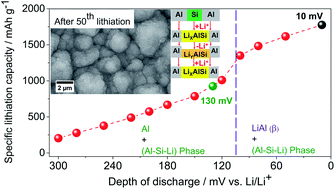In situ formation of aluminum–silicon–lithium active materials in aluminum matrices for lithium-ion batteries†
Abstract
Despite the tremendous theoretical capacities of new materials for lithium-ion battery (LIB) anodes (e.g. Si, Sn, etc.), the conventional design of these electrodes with binders, current collectors, and conductivity enhancers inhibit the translation of performance gains during commercialization. Therefore, consideration should be given to monolithic materials systems which can increase performance while simultaneously reducing design complexity. In the present study, aluminum–silicon thin-films were synthesized with compositions ranging from 0 to 45 at% Si, and the structure, morphology, and electrochemical behavior of the material as an electrode for LIBs were investigated. This analysis confirms that the Li9AlSi3 phase is formed during initial lithiation, prior to the formation of the β phase, and is recognized as the dominant phase in the Al–Si–Li alloy system. These findings also show that by preventing the formation of the β phase during lithiation of the electrode results in an excellent cycling life performance of 70 at% Al–30 at% Si electrode over 100 cycles at the rate of C/20 and a specific capacity of 650 mA h g−1. In situ stress measurements and ex situ SEM analysis performed during cycling confirm the reversibility such that no degradation or delamination is observed in the films despite the high capacity and long-term cycling.



 Please wait while we load your content...
Please wait while we load your content...